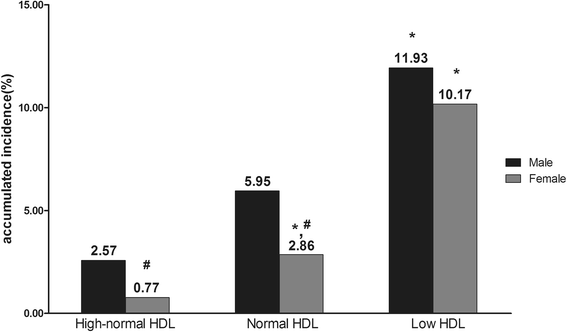Association of high-density lipoprotein with development of metabolic syndrome components: a five-year follow-up in adults
- PMID: 25896058
- PMCID: PMC4409998
- DOI: 10.1186/s12889-015-1747-9
Association of high-density lipoprotein with development of metabolic syndrome components: a five-year follow-up in adults
Abstract
Background: High-density lipoprotein (HDL) is associated with the incidence of metabolic syndrome (MetS). It is unclear whether subjects with different HDL levels develop different components of MetS over time. Our study aimed to determine what MetS components tend to emerge and change relative to different levels of HDL.
Methods: During the period 2007 to 2012, 4,905 adults in Tongren and Xiaotangshan Hospitals in Beijing were included with no MetS, self-reported type 2 diabetes, or cardiovascular disease at baseline. An association rule was used to determine the changes of MetS components over time.
Results: The incidence of MetS at follow-up was 3.40% for men and 1.50% for women in the high-normal HDL group; 6.65% and 4.55%, respectively, in the normal HDL group; and 11.05% and 6.45%, respectively, in the low HDL group. The most common transition was from healthy to healthy in normal-high or normal HDL groups (47.2% to 63.8%), whereas 11.7% to 39.9% of subjects with low HDL returned to healthy status or stayed unchanged in the low HDL group. The most common new-onset components were elevated blood pressure (9.2 to 10.0%), elevated high-density lipoprotein (5.5 to 11.0%), and raised fasting glucose (5.4 to 5.5%) in the groups with normal-high or normal HDL.
Conclusions: The incidence of MetS increased in parallel with the decrease in HDL. Adults with a low HDL level were more susceptible to developing MetS over time. Low HDL seemed to be a pre-existing phase of MetS and may be a crucial status for MetS prevention.
Figures



References
-
- Del Brutto OH, Zambrano M, Penaherrera E, Montalvan M, Pow-Chon-Long F, Tettamanti D. Prevalence of the metabolic syndrome and its correlation with the cardiovascular health status in stroke- and ischemic heart disease-free Ecuadorian natives/mestizos aged >/=40 years living in Atahualpa: a population-based study. Diabetes & Metabolic Syndrome. 2013;7(4):218–22. doi: 10.1016/j.dsx.2013.10.006. - DOI - PubMed
-
- Wang F, Ye P, Hu D, Min Y, Zhao S, Wang Y, et al. Lipid-lowering therapy and lipid goal attainment in patients with metabolic syndrome in China: Subgroup analysis of the Dyslipidemia International Study-China (DYSIS-China) Atherosclerosis. 2014;237(1):99–105. doi: 10.1016/j.atherosclerosis.2014.08.023. - DOI - PubMed
Publication types
MeSH terms
Substances
LinkOut - more resources
Full Text Sources
Other Literature Sources
Medical

